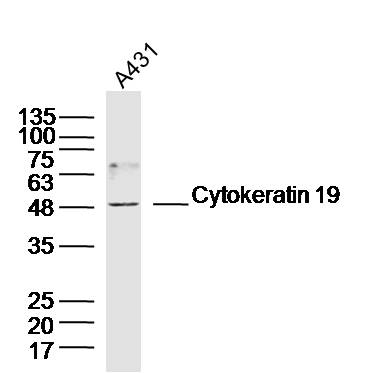Cytokeratin 19 antibody [N1C1]
GTX112826
ApplicationsImmunoFluorescence, Western Blot, ImmunoCytoChemistry, ImmunoHistoChemistry, ImmunoHistoChemistry Paraffin
Product group Antibodies
TargetKRT19
Overview
- SupplierGeneTex
- Product NameCytokeratin 19 antibody [N1C1]
- Delivery Days Customer9
- Application Supplier NoteWB: 1:500-1:3000. ICC/IF: 1:100-1:1000. IHC-P: 1:100-1:1000. *Optimal dilutions/concentrations should be determined by the researcher.Not tested in other applications.
- ApplicationsImmunoFluorescence, Western Blot, ImmunoCytoChemistry, ImmunoHistoChemistry, ImmunoHistoChemistry Paraffin
- CertificationResearch Use Only
- ClonalityPolyclonal
- Concentration1 mg/ml
- ConjugateUnconjugated
- Gene ID3880
- Target nameKRT19
- Target descriptionkeratin 19
- Target synonymsCK19, K19, K1CS, keratin, type I cytoskeletal 19, 40-kDa keratin intermediate filament, CK-19, cytokeratin 19, keratin 19, type I, keratin, type I, 40-kd
- HostRabbit
- IsotypeIgG
- Protein IDP08727
- Protein NameKeratin, type I cytoskeletal 19
- Scientific DescriptionThe protein encoded by this gene is a member of the keratin family. The keratins are intermediate filament proteins responsible for the structural integrity of epithelial cells and are subdivided into cytokeratins and hair keratins. The type I cytokeratins consist of acidic proteins which are arranged in pairs of heterotypic keratin chains. Unlike its related family members, this smallest known acidic cytokeratin is not paired with a basic cytokeratin in epithelial cells. It is specifically expressed in the periderm, the transiently superficial layer that envelopes the developing epidermis. The type I cytokeratins are clustered in a region of chromosome 17q12-q21. [provided by RefSeq]
- Storage Instruction-20°C or -80°C,2°C to 8°C
- UNSPSC12352203
References
- Moriggi M, Pastorelli L, Torretta E, et al. Contribution of Extracellular Matrix and Signal Mechanotransduction to Epithelial Cell Damage in Inflammatory Bowel Disease Patients: A Proteomic Study. Proteomics. 2017,17(23-24). doi: 10.1002/pmic.201700164Read this paper
- Chen Y, Wong PP, Sjeklocha L, et al. Mature hepatocytes exhibit unexpected plasticity by direct dedifferentiation into liver progenitor cells in culture. Hepatology. 2012,55(2):563-74. doi: 10.1002/hep.24712Read this paper






![WB analysis of MCF-7 cell lysates using GTX80226 Cytokeratin 19 antibody [BA-17] (Biotin).](https://www.genetex.com/upload/website/prouct_img/normal/GTX80226/GTX80226_20191028_WB_1_w_23061322_765.webp)